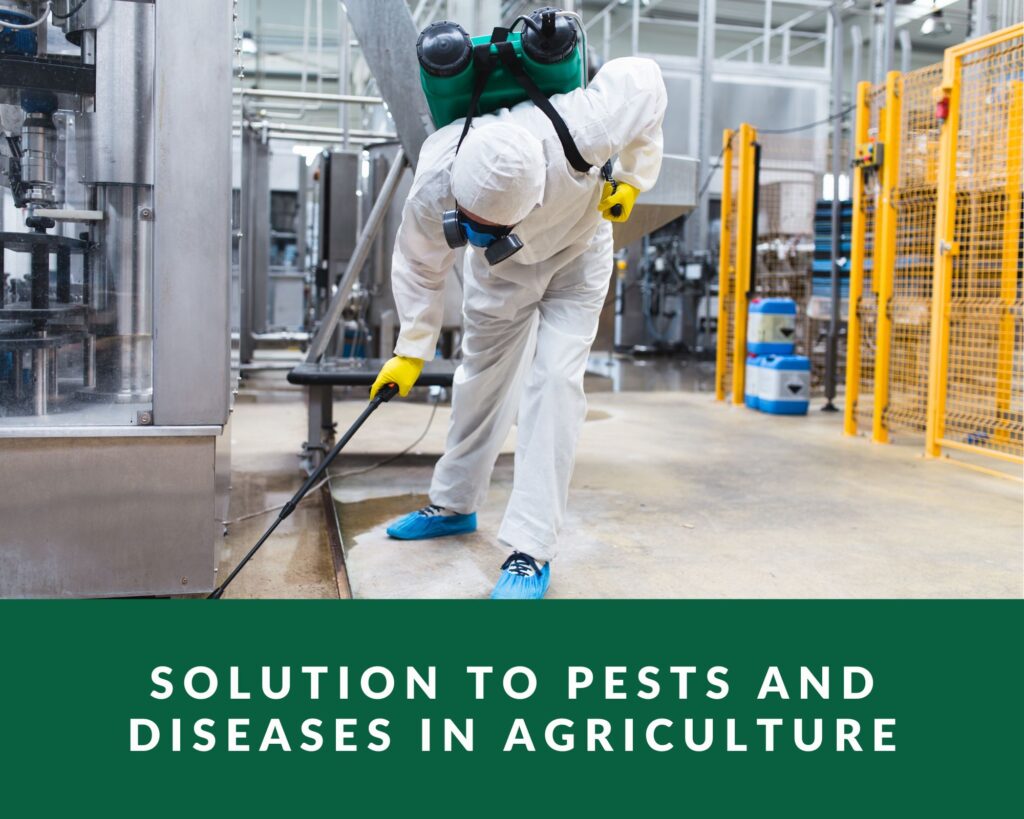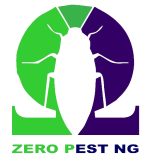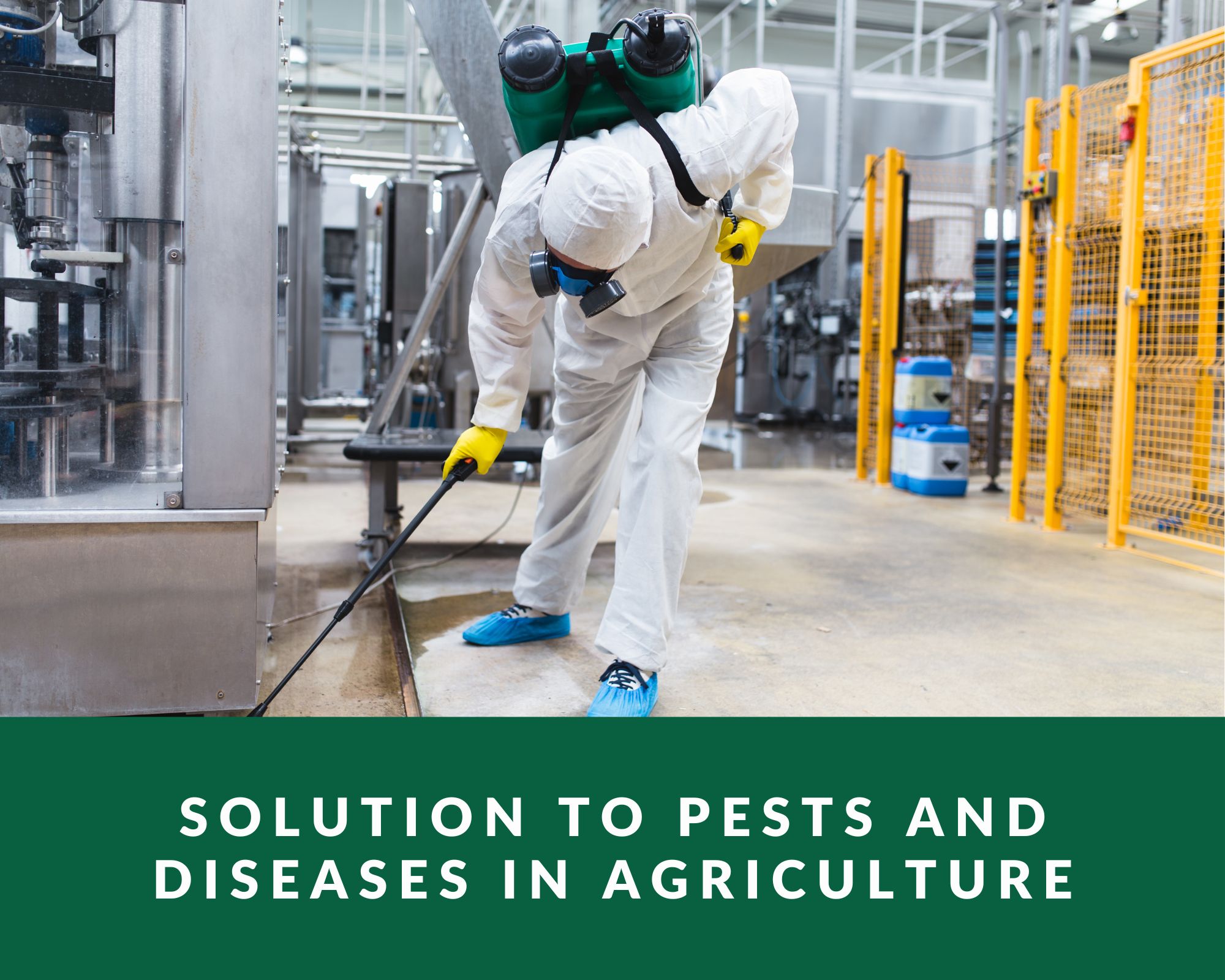
Solution to pests and diseases in agriculture
It does not matter where agriculture is practiced, the kind of region the crops are being planted, or even the kind of crops planted, one constant thing is the presence of pests and diseases.
Pests have attacked and destroyed crops for as long as can be remembered, and they will continue to do so. For more context, pests are animals, insects, bacteria, fungi, and viruses that cause damage to plants and animals in farmland.
Importance of Agriculture
Agriculture is a fundamental part of human civilization and provides many essential benefits that support our daily lives. Here are five important reasons why agriculture is crucial:
Food Production
Agriculture is primarily concerned with the production of food. It provides the necessary nutrients required by human beings to survive. Agriculture ensures that we have enough food to feed ourselves and the growing population.
Economic Development
Agriculture plays a significant role in the economies of many nations. It produces money, creates job opportunities, and supports a country’s general economic growth.
Environmental Sustainability
Agriculture is a key factor in maintaining the environment. It is in favor of safeguarding natural resources including soil, water, and biodiversity. Sustainable agricultural methods encourage resource preservation and aid in reducing the damaging effects of agriculture on the environment.
Development of Rural Areas
Agriculture plays a crucial role in the development of rural areas. It provides employment opportunities, improves infrastructure, and enhances the standard of living for rural communities.
National security
Agriculture is crucial for ensuring national security. It offers food security, which is crucial for a country’s survival. Also, agriculture helps local businesses grow, which lessens reliance on imports from abroad and boosts national security.
The Problem of Pests and Diseases in Agriculture
Pests and diseases can have a devastating effect on crops, leading to significant economic losses, food shortages, and famine.
Some of the common pests that attack crops include insects, rodents, and birds. They can cause damage to crops by feeding on them or by transmitting diseases.
Symptoms and Signs of Pests and Diseases in Agriculture
Pests and diseases can cause various symptoms and signs in crops that can help farmers identify their presence. Early detection of pests and diseases is crucial to prevent their spread and reduce their impact on crop yields.
Here are some common symptoms and signs of pests and diseases in agriculture:
- Yellowing or Discoloration
- Stunted Growth
- Holes or chewed leaves
- Powdery mildew or other fungal infections
- Root rot
- Pest or insect Infestations
- Deformed Leaves or Fruit
- Wilting
Mitigating the Impact of Pests and Diseases on Agriculture
There are several measures that farmers can take to mitigate the impact of pests and diseases in agriculture. Some of these measures include:
1. Crop rotation
Crop rotation is an effective way to reduce the incidence of pests and diseases. It involves growing different crops in the same field over several years. This practice disrupts the life cycle of pests and diseases, reducing their impact on crops.
For crop rotation to properly work, the pest must spend the period from the end of one crop lifecycle to the beginning of another. There has to be proper planning involved as some pests travel across single farmland in their entire lifespan and do not stay in one location.
2. A rich soil
When you have very rich soil that has been maintained by organic methods, the plants would not only bear rich fruits, but they would also be resistant to pests and diseases. If the soil you’re planting on is weak, then it is very likely that the crops would be more prone to pests and diseases.
So, caring and making sure your soil is as healthy as possible is very essential. Taking care of your soil involves putting in regular organic input of plant and animal remains to keep the soil as healthy as possible. This maintains the level of nutrients in the soil and also provides nutrients to crops.
Most chemical fertilizers harm the crops so it would be best to go in with natural fertilizer. According to research, some pests thrive more in soil that has chemical fertilizers than those that do not.
3. Planting resistant crops
There are crops available that have been biologically modified to be able to resist pests and diseases. These crops have been saved and planted particularly to be able to resist pests and diseases.
Some plants have been bred in recent times to be susceptible to some types of diseases and if one plant has said disease, then all the other ones have it as well.
A wide variety of crops in farmland is very important as this helps the crop to resist pests and diseases. It is very important to know this when choosing the kinds of crops to grow.
4. Natural pesticides
Since some pests and diseases have become susceptible to chemical pesticides, it would be best to try other methods. Some farmers have made natural pesticide sprays with things like garlic, chilies, and some other natural ingredients.
One thing about natural pesticides is that it is very affordable and even small and large-scale farmers can use them without any problems.
Some ways to make natural pesticides are;
- Making a watery solution by mixing marigolds using water and soap. This mixture serves as a crop intensifier to help potatoes, tomatoes, and some other crops from fungal diseases. It is also a great way to repel some insect pests like aphids, caterpillars, and the like.
- Another kind of spray that is pretty popular is garlic spray. This one is very good as it prevents worms from causing damage to the crops or going underneath the soil to harm the plant roots. Garlic is also a great pesticide for nematodes.
5. Hand picking
This method can be a very slow way of getting rid of pests on the farmland but one thing about it is that it is very effective when done right.
You can just pick some pests directly off crops and it can be done with larger insects, caterpillars, and some other kinds.
It also works for diseases as well and if you don’t want to be said disease to spread, you can cut off some of the plant parts that have been infected to prevent the spread of the disease.
6. Soil tillage
In a pest life cycle, they usually spend their time underneath the soil as larvae or even eggs before they hatch and begin to feed on plants.
When you plow or turn over the soil, the larvae are exposed and this will cause the larvae to dry out and die from the sunlight streaming down on them. Another way to get rid of them using soil tillage is when they are exposed, you can introduce natural predators to swoop in and take care of the situation for you.
7. Crop Resistant Varieties
Farmers can use crop varieties that are resistant to pests and diseases. These varieties are developed through breeding and genetic modification and can significantly reduce the impact of pests and diseases.
Control Strategies for Specific Pests and Diseases
There are various pests and diseases that can affect crops, and each requires a specific control strategy. Here are some strategies you can employ:
- Aphids: insecticidal soaps, neem oil, and horticultural oils. Introducing natural predators such as ladybugs and lacewings can also help control aphids.
- Spider Mites: horticultural oils and insecticidal soaps. Spraying plants with a strong jet of water can also help dislodge spider mites from the plants.
- Whiteflies: insecticidal soaps and horticultural oils.
- Fungal Diseases: Fungal diseases such as powdery mildew and downy mildew can be controlled using fungicides.
- Bacterial Diseases: copper-based fungicides and antibiotics.
- Viral Diseases: by removing infected plants and controlling the vector that spreads the virus, such as aphids or whiteflies.
- Nematodes: crop rotation, planting nematode-resistant varieties, and using soil solarization or fumigation.
- Weeds: Weeds can be controlled using herbicides, hand weeding, and mulching.
- Rodents: Rodents can be controlled using traps, baits, and exclusion methods such as fencing and netting.
The Bottom Line
There are so many methods to get rid of pests and diseases in agriculture without resorting to the use of chemical pesticides. The above ways are just some of the few methods that can be done. Ensure they are implemented or you can resort to something that fits you and your farmland more.

